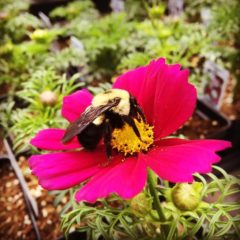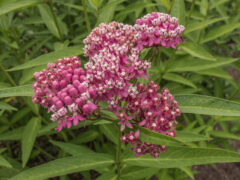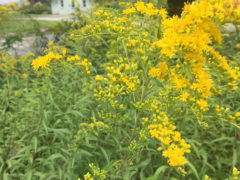 The third Saturday in August is World Honey Bee Day! With 20,000 species worldwide, this day celebrates the importance of bees in our world by helping spread awareness of the dangers bees face, along with suggested ways to help them.
The third Saturday in August is World Honey Bee Day! With 20,000 species worldwide, this day celebrates the importance of bees in our world by helping spread awareness of the dangers bees face, along with suggested ways to help them.

Together with sunlight, soil and water, pollinators play an essential role in flowering plant survival. 80% of all crop plants that feed us rely on pollinators, including ants, beetles, butterflies, flies, birds, hummingbirds, moths, and bees. Pollinator populations have taken a huge hit with habitat loss, climate change, and pesticides. We’re growing plants to help mitigate this problem, and you can help by planting them in your landscape!
Following is a recommended list of plants (including many local natives) that will attract and feed pollinators. They have the most impact when planted in groups in full sun, and of course, you should never use pesticides in your pollinator garden. Pick up a pesticide-free sign for your pollinator plot when you purchase plants and help spread the word.
lead plant
Amorpha canescens
This native shrub grows in woodlands and prairies. 4-8" spike-like clusters of tiny, bluish-purple flowers with gold anthers are unusual.
swamp milkweed
Asclepias incarnata
Swamp milkweed sports lightly fragrant flower clusters from early summer through fall. Plants grow 3-5' tall. Choose the pure native pink or the selection called 'Cinderella'. As the name suggests, this species is tolerant of poorly drained sites.
false indigo
Baptisia australis
Related PlantsPerennial Plant Association 2010 Perennial Plant of the Year!
Baptisia australis is an upright native perennial which occurs in rich woods, thickets and along stream banks from Pennsylvania south to North Carolina and Tennessee.
Easily grown in average, dry to medium, well-drained soil in full sun to part shade, false indigo grows best in full sun. Tolerates drought and poor soils. Plants form slowly expanding clumps with deep root systems that should not be disturbed once established. Shearing foliage after bloom helps maintain rounded plant appearance. Beautiful, showy native plant!
Plants feature lupine-like flowers in erect 12" racemes over clover-like blue-green foliage. Spring flowers give way to inflated seed pods up to 2.5" long which turn charcoal black when ripe and have considerable ornamental interest. Seed pods were once popularly used by children as rattles. Now we have iPods.
Stems with seed pods are valued additions to dried flower arrangements.
According to the North American Butterfly Association –
Blue Wild Indigo belongs to the plant family Fabaceae, also known as the pea family. Plants in this plant family feed a number of caterpillars. Depending on your location and availability of competing food plants (most notably crown vetch and alfalfa), the following caterpillars may use blue wild indigo for food:
[plant id="5140"]
[plant id="6099"]
Frosted Elfin: Caterpillars eat flowers and young seedpods. Frosted Elfin is not a common garden butterfly.
Orange Sulphur: Caterpillars eat the leaves of many plants in the pea family. Feeding occurs at night.
Clouded Sulphur: Caterpillars eat leaves of many plants in the pea family.
Hoary Edge Skipper: Individual eggs are laid in flower buds. Caterpillars eat flowers and seedpods. Hoary Edge is found only in localized populations and is not a common garden butterfly.
Wild Indigo Duskywing: A widespread butterfly that is fairly common in its range.
Eastern Tailed-Blue: A common garden butterfly. Caterpillar eggs are laid on flower buds and the caterpillars then eat the bud, flowers, and seeds.
purple poppy mallow, wine cups
Callirhoe involucrata
Low-growing mounds of cut-leaves are covered with large, purple, cup-shaped flowers all summer. Can self-seed and spread once established. Grows in hideous clay soil, and heat and drought only slow its growth slightly! An excellent border plant and ground cover.
buttonbush
Cephalanthus occidentalis
This deciduous shrub has an open, rounded habit. Common throughout the midwest, it can most frequently be found in wetland areas and ditches, swamps, river bottomland and stream/pond margins. Tiny, tubular, fragrant white flowers appear in dense, long-stalked bunches in early to mid-summer. Flowers have a distinctively pincushion-like appearance and are very attractive to bees and butterflies. Flowers mature into hard spherical ball-like fruits consisting of multiple tiny two-seeded nutlets that usually persist throughout the winter. Attracts Tiger Swallowtail, Painted Lady, Silver-Spotted Skipper butterflies.
white prairie clover
Dalea candida
White flowering spikes bloom over airy, delicate foliage. Prefers well-drained soil and full sun. White prairie clover grows in many habitats, including prairie, foothills, woods, forests, and disturbed areas. A great pollinator host and nitrogen fixer. It is a larval host to the clouded sulphur, marine blue, Reakirt's blue, and southern dogface butterfly.
purple coneflower
Echinacea purpurea
Showy purple flowers in July and August on plants that grow to 2-3'. Like its cousins, flowers make great cuts, butterflies are attracted to the flowers and birds appreciate the seed when cones are left to dry.
rattlesnake master
Eryngium yuccifolium
Beautiful native growing to 4' tall with glaucus, yucca-like foliage topped with clusters of white, globe-shaped flowers in late summer through early fall. Wonderful ornamental qualities with excellent drought and heat tolerance.
blanketflower
Gaillardia aristata
Blanketflowers are one of the longest-blooming native perennials, well suited to hot sunny sites. Soft-yellow daisy petals with a scarlet eye, surrounding a deep burgundy-red button center. Removing faded flowers will greatly extend the blooming season. Supports a diversity of bees including green metallic sweat bees (Agapostemon spp.), bumblebees, and others who are drawn to the brightly colored flowers. According to Xerces, Gaillardia aristata is also a larval food source for caterpillars of the brilliantly colored gaillardia flower moth (Schinia masoni) and painted schinia (S. volupia), butterflies with wing patterns and colors that mimic blanketflower’s petals.
Maximilian sunflower
Helianthus maximiliani
State flower of Kansas
Clusters of bright yellow flowers in September atop 6-8' stalks. An important livestock food source that also feeds birds. A sensational native with an explosion of huge bright daisies. Give this plant plenty of room to grow! Well-suited to any type of soil, including clay. Songbirds will appreciate the seeds and native bees are fond of the nectar-rich sunflowers.
Virginia sweetspire
Itea virginica
'Little Henry' is a gorgeous native selection that prefers moist soils and will tolerate wet conditions. It will grow in full sun to full shade, and requires little pruning or other maintenance. Lightly scented, pure white flowers shoot like fireworks in the early summer. and the mounded, compact size offers a small space alternative to 'Henry's Garnet'. It is also a delightful addition to the mixed border. One of the best pollinator plants you can offer in your landscape. Incredible fall color makes this a must-have for every landscape.
prairie blazing star
Liatris pycnostachya
An outstanding native of the great plains grows even in wet prairies. Breathtaking in gardens and bouquets. Produces a 1' or larger dense spike crowded with reddish-purple, long-lasting flowers on 3-4' spikes. A must for butterfly gardens.
hairy beardtongue
Penstemon hirsutus
short-toothed mountain mint
Pycnanthemum muticum
2025 Perennial Plant Association Plant of the Year®
Attracts beneficial garden insects like crazy — honeybees, butterflies, beneficial wasps, and moths cover the tiny flowers accented by fuzzy white bracts over blue-green foliage, which is incredibly fragrant. A must for any butterfly garden.
Plants are loaded with pulegone, the same insect repellent found in pennyroyal, and can be rubbed on the skin to repel mosquitoes!
Mexican hats
Ratibida columnifera
Round, dense, fine foliage is covered with 1" blooms of yellow, red and bicolor flowers with petals drooping back from the center cone. A wonderful self-seeder, this native blooms from late spring until fall, and even grows in the gravel at Vinland Valley Nursery!
pitcher sage
Salvia azurea
Showy large flower spikes of sky blue in late summer and fall. The perfect color contrast for the hot reds and oranges of fall. Drought tolerant. Grows 2-4' tall.
Larval host to the sage sphinx moth.
Showy Goldenrod
Solidago speciosa
Showy goldenrod is a rhizomatous native perennial which typically occurs in dry soils in open woods, fields and prairies. Tiny, bright yellow blooms open in dense clusters atop stiff, reddish stems growing 2-3' tall. Flowers bloom mid to late summer. As the common name suggests, this species is one of the showiest of the many goldenrods. Goldenrods have been wrongly blamed for causing hay fever which is actually an allergic reaction to wind-borne pollen from other plants such as ragweed. Attractive to bees and butterflies searching for late-season nectar, and especially valuable to migrating Monarchs.
Used by long-tongued bees, short-tongued bees, wasps, flies, beetles, butterflies, and caterpillars of many Lepidoptera species. An important late-season nectar source for pollinators.
‘Wood’s Purple’ New York Aster
Symphyotrichum novi-belgii 'Wood's Purple'
New York aster is a low-maintenance perennial for average, medium moisture, well-drained soil in full sun. The Novi-belgii species is valued for its compact growth habit, rich flower color, and floriferous tendencies. 'Wood's Purple' flowers open over a long season, from late summer through fall. Low-maintenance, mildew-resistant, compact plants provide late-season nectar for pollinators. Selected for low-growing height, plants grow only 12" tall and wide. Symphyotrichum novi-belgii is a larval host plant for caterpillars of the pearl crescent (Phyciodes tharos).
Ohio spiderwort, bluejacket
Tradescantia ohiensis
Grassy blue-green foliage is covered with true blue blooms from May through July. Grows very well in part shade although plants may flower less profusely blooms may be less.
The Xerces Society has lists Ohio Spiderwort as 'Special Value to Native Bees' for attracting a large number of native bees, including bumblebees.rose verbena
Glandularia {Verbena} canadensis
Brilliant pink flower clusters cover this low-growing wildflower all summer. Plants spread out to 15-18" and make an excellent border edging. Butterflies love this full sun perennial.
Baldwin’s ironweed
Vernonia baldwinii
Stems occur singly or in clumps with wide clusters of vibrant red-violet blooms at the ends of short branches near the top of the plant. Six-inch wide flower clusters have a fuzzy appearance. Long, lance-shaped leaves line the stems. This plant aggressively colonizes by rhizomes once established so place accordingly. Its bloom period lasts until frost.





















